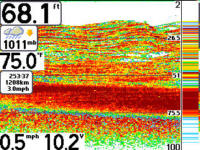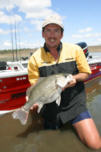|
Heavy
Metal on Bass by Garry Fitzgerald
|
It
wasn't that long ago that many a fishing writer was claiming lake
bass (Australian) were a "summer only" prospect and
that they would never be found much deeper than 30 feet. Recent
years have seen feet pried from some mouths and previous theories
blown out of the water, pardon the pun.
Probably the first bass waters to prove the pundits wrong were
the twin lakes of Wivenhoe and Somerset in southeast Queensland.
Large bodies of water and healthy food webs with literally tons
of bony bream, bait fish, shrimps etc have seen bass growth rates
among the best going. The proof is most certainly in the pudding
with Somerset in the past and more recently Wivenhoe being record
setting lakes for bass style competitions. In fact, winter is
the best time to be out on the bigger lakes if big bass is what
you are after.
Often
the key to successfully crossing paths with a trophy bass is having
an idea on a bass' life cycle.
In wild situations, all small bass are males. At around 30 centimeters
in length they change into females.
Come mid to late winter, bass usually move downstream into brackish
water to spawn. While bass stocked into lakes cannot get over
the dam wall to go spawn, instinct drives the females to go through
the process of making eggs in preparation for spawning. All of
this egg production requires food and lots of it.
This in mind, it doesn't take a rocket surgeon to work out that
this is why big bass feed heavily coming into and during the winter
months.
Now
that we're over that hurdle, how the hell do we find them? Another
advantage for anglers is the fact that many bass form schools,
often of roughly the same size fish. Schools can vary in size
from a half dozen fish to hundreds and even thousands. Throughout
any given day bass will school up and break apart to actively
hunt around break lines, on flats areas and in shallow margins,
depending on the food within that lake.
|
A
good quality sounder is essential to finding schools of
bass, the better the sounder, the better your results can
be. It is even more important to track down fish that are
out on their own actively hunting for a feed.
Sounders with high pixel counts, ease of use and multi beam
transducers are the things to look for; Humminbird Matrix
units are leaders in field.
Assuming
you've found some fish on your sounder, how do you catch
them? A proven method for catching both schooled up and
scattered bass in winter is jigging for them. Jigs, in reality,
can be any lure that sinks and can be worked across the
bottom or worked in a vertically way. Soft plastics, bibless
lures, slugs, blades, spoons, tail spinners, spinner baits,
ice jigs; the list goes on and on. You can spend $20 - $30
on the latest bibless lures eg Jackal, Team Daiwa or you
can spend $6 - $7 on slugs like Halco Twisties and Raiders
and often get the same success. Yes, your typical tuna or
tailor style slugs do work! Often the hardest thing to do
is to get a jig to stay where the fish are.
|
.jpg) |
|
This
Matrix 97 screen shot shows an active bass school
on flats country. Click on pic for
larger view
|
|
Its
all well and good in optimal weather conditions with no wind
or waves to contend with, but Murphy usually plays his part
in any fishing trip.A general rule is that the windier it
is, the heavier your jig will need to be to get to where the
bass are, usually at or close to the bottom. Clever anglers
can use wind to their advantage.
Instead of fighting the wind and waves, set yourself up doing
drifts across the areas you just found fish or suspect there
will be fish holding. In this situation you can free spool
a jig to the bottom and work it with high rod lifts. For example,
using a seven foot rod you can lift from the rod tip touching
the water to almost vertical.
This can give close to a 10 foot rise in a jig, don't let
that bother you cause it commonly wont bother big bass.
After the rod has been lifted, drop the rod tip at a speed
where you are just staying in contact with the jig.
Heavier jigs will sink faster, larger or lighter jigs will
sink slower. This will allow you to feel any strikes on the
drop (a common occurrence) and react accordingly. At other
times all that is required is a lift of only a few inches,
especially when bass are holding close to the bottom. The
best method can vary from day to day so if you know you have
fish under the boat, experiment to find out what the fish
prefer on that day.
If you are having trouble reaching the bottom while drifting,
either let more line out or change to a heavier jig.
|
 |
|
Another
M97 Screenshot showing a bass anglers dream screen.
There a litterally 1000s of bass here from 12 feet
of water to the bottom in 68 feet.
|
|
What
gear to use?
Rods
Your average light bream or bass rods aren't usually the best
for jigging, particularly heavy jigs like 50 or 55 gram Twisties
or Raiders etc.
A stiffer, high modulus rod is ideal for effective jigging, if
you have a favorite barra over head rod, this will usually suffice.
The reason a stiffer is better is that sometimes you only need
to move your jig a few inches at a time.
If a light rod is used, a lift of a few inches at the rod can
mean little or no lift at the jig end.
Line
Braided lines are not mandatory, but they will vastly improve
jigging results. Braided lines, or GSPs, are thinner and have
far less stretch than monofilament lines. These attributes can
and will allow you to fish deeper, faster and feel a lot more
of those timid taps that can often be the only clue that you have
an interested bass.
Locations
Not all bass lakes are going to be good locations for jigging
bass in winter. Some of the better ones to try, water levels depending,
are Somerset, Wivenhoe, Moogerah, Boondooma and Barambah.
Places within these lakes to begin looking are:
- Large flat areas of bottom with anywhere from 20 - 40 feet depth.
- Break Lines. Areas where some feature breaks the bottom eg river
channel, submerged hilltop or ridge.
Jigging
for big bass is certainly one of my favorite styles of fishing
being right up there with surface luring for bass and barramundi.
With a little effort to work out some of your own tricks on catching
big winter bass, I'm sure it can be one of yours as well.
Give it a try.
 |
 |
 |
|
Fitzy
with one of his winning Bass at the 2005 BASS Electric Convention
|
Armed
with the right advice, even beginners can quickly get onto
big bass
|
Big
Bass should be supported properly when being held. Lip lifting
will kill them.
|
Click
on images for larger version
Garry
Fitzgerald
Related
Topics:
2005
Bass Electric Grand Final. Lake Wivenhoe Results.
Surface
Luring for Australian Bass - Garry Fitzgerald
Big Bass
at Big W - Garry Fitzgerald
Top
Water Fishing - Roger Lee Brown




.jpg)



